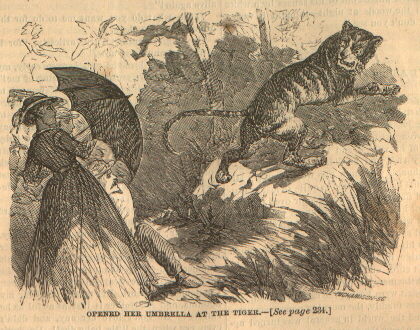“A Frightened Tiger” (from Youth’s Companion, July 29, 1869; p. 234)

Illustration on p. 233
The “Royal Bengal Tiger” lay sleeping in his cage.
No menagerie is considered complete without one.
“He is most always asleep,” said old Jorl, the gymnast. “That’s a tiger’s nature—to doze all day long. In his wild state, he prowls all night for his food. He is a furious creature when he is hungry, and it’s safer to go into a jungle along toward noon, after the creature has had his morning meal, and laid down to snooze through the day—though as a matter of safety, it’s as well not to go into the jungle at all, perhaps.
“You may talk about your lions—I have always said, and I always will say, that for pure blood-thirstiness and ferocity, the tiger is a far uglier beast than the lion. The tamest tiger that ever was, just let him snuff blood once, when he is hungry, and nothing can hold him!
“And yet, terrible as he is, the tiger is like all wild beasts—a coward at bottom.
“My idea of cowardice, sir, is just this—to run away from, and be scared by, a thing that is not in itself dangerous. No wild beast knows what it is to feel bravery! They know what it is to be hungry, and when they are hungry they will fight—but they want to see safety on their side, even then.
“Now a tiger knows his own strength. He knows he can grab a whole buffalo and run off with him. He knows he is even a match for an elephant in a square fight. And he knows that a man is a mere plaything in his paws when he has once seized him by the back of the neck.
“But let him see a man well on his guard—does he attack him openly, boldly? Not he. Deadly, secret, remorseless, he sneaks about, dogging the man’s steps, till he can spring on him from behind.
“Did I ever tell you that story about a gymnast—a friend of mind—who scared away a lion by just tying himself up in a knot and flopping down in the lion’s path? That was a fact; and I knew of a tiger that was scared off by a trick just as simple as that. It would be almost too ridiculous to tell, if it wasn’t for it’s being strictly true; but it is true.
“I was in Bengal at the time, and though I didn’t see the occurrence, there were those who did, and among them some of the most respectable gentlemen and ladies I ever met.
“You see there was a party of them, who had in the morning strolled into the jungle a short distance for the sake of the shade and the coolness.
“They had found a delightful place, down by the bank of a river, where they took seats, and spread out a little lunch they had brought along.
“They were full of laughter and merriment, when suddenly one of the men cried out,—
“ ‘The tiger!’
“And looking up, the party saw an immense Bengal tiger on a rocky elevation close by, with his haunches drawn down to the ground, his eyes blazing, all prepared for the deadly spring upon his prey.
“An instant more, and he would have bounded headlong upon them; for the men had not time to spring to their guns, take aim and fire. He was in the very act, you see.
“Well, sir, at that critical moment what does one of the ladies do in her fright, but stick out her umbrella at the tiger, and suddenly open it right in the creature’s face!
“A curious thing for a lady to do, you’ll say—but after all, her object was only to shut the horrible sight away from her eyes, I suppose. At any rate, what the beast did was, to turn tail instanter, and slink off into the wood.
“You better believe that party scrambled to their feet and scattered!
“The reason why the tiger ran away, I think is a very simple one—he was scared. This was a sort of thing such as he had never seen before in all of his experience, and he didn’t know what to make of it; hence it frightened him—and it’s not wonderful that it did. I’ve seen a man scared almost out of his sense by a white tree in the woods at night—thought it was a ghost, don’t you see.”